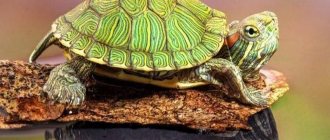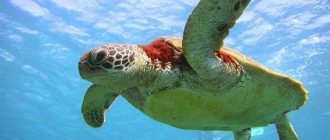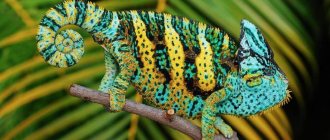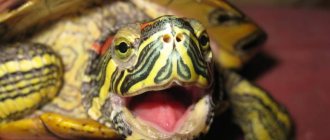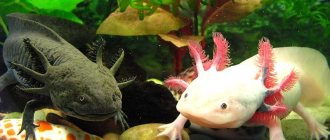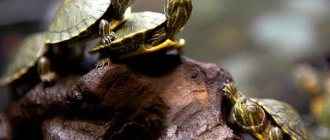Today, an increasing number of people who want to get a pet prefer exotic animals rather than cats and dogs. But at the same time, they do not understand that such animals require special care. For example, owners of red-eared turtles often wonder how to wash their pets. However, there is nothing complicated about it. It is enough to follow simple recommendations from veterinarians so as not to harm the turtle.
Molting time for red-eared turtles
Do not be alarmed when the red-eared slider begins the molting process.
This is a natural process that occurs in a young individual during a period of active growth. The reptile grows quite quickly and the shell simply cannot keep up with its growth. Therefore, all or part of the shell peels off. This process is absolutely safe for the turtle, but during this period it needs special care. A turtle in the early stages of its development may experience complete peeling of the top layer of its shell. As the turtle matures, the amount of dead tissue decreases. This is no longer the entire upper layer of the reptile’s shell, but only part of it. After some time, the red-eared slider's molting stops.
How can you tell if a turtle is growing?
The growth of the turtles can be seen by the light seams between the carapace scutes. If the turtle grows quickly, the new horny layers along the periphery of the scutes become very light, then processes of pigment cells (dermal melanophores) grow there and pigment is transferred along them, usually in the form of thin rays or dark spots.
Interesting materials:
Which word repeats no 100 times? Which word has 2 syllables? Which word has two syllables? Which word has an unpronounceable consonant? In which word can an adverb not be replaced by a synonym without NOT or an expression similar in meaning? In which word do you need to remember the spelling of the prefix pre? Why was there a hard sign at the end of words? Why are words borrowed from other languages? What is remarkable about a point on the optical axis of a convex lens called focus? What is a swimming pool?
Nutritional conditions of adults
When keeping a red-eared slider at home, you should know that they feed in water. That is, the food will have to be poured directly into the aquarium. Monitor what she has eaten and remove any leftover food. Some breeders organize a special separate container for this purpose. The pet is fed in it, waits for a bowel movement, and is transferred back. At this moment it is very convenient to immediately take care of the owner of the aquarium.
Adults happily eat bloodworms, squid, and meat. You can give thawed frozen fish along with bones - this will solve the problem of calcium deficiency. Perch fish, if it is large enough, should be disassembled and the rib part of the bones removed, and the spine simply cut. Fish bones are a must in the diet. Shrimp are an excellent way out, since reptiles need chitin, which is contained in large quantities in the shell of shrimp. Also, your pet can be treated to special crustaceans, and you should not be afraid of their hard house.
Raw liver should be given once a week; if your pet enjoys eating it, you need to reduce the dose of vitamins. This point, as well as the question of the amount of vitamins required for your pet, should be discussed with your veterinarian.
It is also necessary to include plant foods in the diet, this could be fresh cabbage, spinach, and greens. The main thing is to wash the plants thoroughly.
You can tell that a turtle is hungry by its behavior. A hungry turtle rummages through the rocks, actively explores the corners of the aquarium, and behaves restlessly compared to its usual state, at a time of day when it would usually be asleep.
Aquarium design and maintenance conditions
Arrangement of the aquarium
The red-eared turtle is an amphibian, and therefore it is necessary to arrange an aquarium for red-eared turtles so that 1/3 of the aquarium is occupied by land. It should be a relatively large aquarium as she will grow larger in a couple of years. For one individual you need a volume of 100 liters. There are special models with irregular geometry, where one side is lower; their installation requires a special stand.
The water height for the red-eared turtle should be at least 40 cm. But part of the aquarium territory should be shallow so that the turtle has the opportunity to sit in the water, and at the same time its head is above the water.
For these purposes, you can arrange a slide inside of stones - pellets. They should be smooth. Small pebbles will do.
A small area of land can be decorated by making a glass shelf, the main thing is that you also need to sprinkle pebbles on it.
Lighting of the reptile's place of residence should be considered separately - if the terrarium is located near a window, there will be enough light, but if in a darkened part of the room, you need to organize a separate light source. This reptile loves light and warmth, these are the two most important things for it.
Once the redfish gets comfortable, you will notice that it is trying to get out of the aquarium. This attempt must be stopped immediately. If the sides in the land area are low, you need to think about a special lid, and most often, it is needed only over part of the land. She will not be able to get out of the water, where the edge above the water surface is at least 10 cm, but she will not stop trying to do so.
Children will be tempted to hold it in their hands, and you should warn them that it bites quite hard. Handle it less, this will make the adaptation process more painless.
Temperature and water quality
This is an important part of the conditions of detention, and neglect of them can not only harm the health, but also kill the animal.
Necessary:
- Once every three days, dilute the water in the aquarium with water that has stood for at least 3 days. There is no need to change all the water, it is enough to replace 1/3 of the volume;
- Maintain temperature from 23 to 28 degrees. Special heating devices with an automatic thermometer will help with this. If the temperature is low, the turtle will begin to prepare for sleep, but without accumulating enough calories, it may not wake up again;
- Remove obvious contamination, do not overuse food, so that putrefactive processes do not begin in the water;
- Install a water filter, it will make life much easier for the inhabitants
Water for red-eared turtles at home can be used from the tap, but it must be left in an open container for at least three days. This is necessary so that volatile substances added to the system, such as chlorine, evaporate from the water.
Remember that there should always be clean water in the aquarium, excrement must be removed, and it is enough to remove the inhabitant once a week and wash with clean water. Wash the shell with a soft cloth, but remember that it bites. Clean the decorations, but be careful not to get any cleaning products into the aquarium.
Aquarium decorations
The red-eared turtle remains a predator at home. If you decide to decorate her house with living vegetation, she will definitely try it and eat it as a result. A decorative plastic bush will suffer the same fate.
For this purpose, you can make a double glass back wall. The main thing is to leave a small gap at the bottom, or drill small holes.
Behind this wall you can keep fish, which, like vegetation, cannot be kept in the same container with the turtle. The size of the holes should be small so that the fish cannot get into someone else's territory or get stuck in them.
Artificial driftwood looks organic, and with their help you can make a platform for reaching land, but for this purpose you need to use special artificial materials. In no case should you adapt wood for this - it will rot in water, and if it is treated with special preparations, it will release harmful substances into the water.
Important: Give maximum attention to the contents of the turtle's aquarium - make sure that there are no elements in it that will injure it, as well as small stones that it can swallow.
Water
A turtle spends most of its life in water
It is important to monitor its cleanliness and change it promptly. Frequent replacement is caused by the need to prevent the emergence of sources of infectious diseases
The water level in the pool should allow the red-eared slider to swim and roll over freely (the depth is greater than the width of the shell). The larger the volume of water, the less often it will have to be changed.
Use an immersion thermometer to monitor the temperature of the aquatic environment. The optimal value for a turtle is between 22 and 24 degrees. If necessary, turn on the water heating.
To avoid the accumulation of waste products in the pool, regularly replace about a third of the water with fresh water. Tap water is also suitable for this, but it must first be left for at least 24 hours.
An obligatory part of the aquaterrarium is a filter. There are both external and internal modifications. Regular water changes are not an alternative to filters, but only an addition.
How long can a red-eared turtle go without water? An escaped animal can easily survive in such conditions for up to two days. However, prolonged stay on land threatens death from dehydration.
Habitat in nature
The red-eared turtle received its original name due to its distinctive external feature: two scarlet-orange spots stretch from the eyes to the neck of the reptile. The turtle’s second nickname is the yellow-bellied turtle, due to the fact that the creature’s abdominal shield is painted bright yellow.
The habitat of the red-eared slider in nature is America, so the variety is often called “American”. Reptiles live near rivers and cannot live without water, but land plays a significant role in nature for the red-eared slider. The lifespan of these reptiles is 30-40 years. Having acquired an exotic pet, the owner should know the nuances of keeping red-eared turtles at home so that the pet lives a long life.
Aquaterrarium
It is better to study the rules for the care and maintenance of these reptiles in advance. And to create a comfortable environment for your pet, buy:
- aquaterrarium made of silicate glass, volume from 150 to 200 l;
- water heater;
- water filter (external or submersible);
- a special ultraviolet lamp;
- heating lamp;
- thermometer;
- lamp;
- landscape elements (land, island, coast);
- equipment for caring for a reptile (cloth, claw clippers, etc.).
Hygiene
Hygiene rules for reptiles are simple and easy to do at home. From time to time, the pet turtle is bathed in a separate container. The water should be warm (above 36 degrees) and cover the animal by two-thirds. It is recommended to add chamomile infusion. If your reptile defecates during water procedures, immediately change the water to clean water.
A hard brush is not suitable for this purpose; take a soft cloth. Do not use foaming products (shampoo, soap) for washing. A dark coating on the shell is algae or fungus. Remove it with special products from the pet store.
Claws are trimmed as needed using reptile clippers.
Carefully! The claws have blood vessels that cannot be injured during the procedure. You can determine their location in the light
At least once a month, the aquaterrarium is thoroughly cleaned:
- The island and walls are washed with a solution of baking soda.
- Decorative elements are washed and treated with boiling water.
- The soil is calcined in the oven.
What do you need for swimming?
They bathe the Central Asian turtle 1 or 2 times a week.
Turtles are very sensitive to chemicals that can cause allergies in them. So skip the shampoo. You won't need a hairdryer either.
But if your pet is very dirty, you will have to use baby or liquid hypoallergenic soap to wash the shell.
Before bathing, stock up on a basin and a brush, foam sponge or rag. When bathing, it is advisable to place a lamp near the bath to avoid colds from hypothermia.
Prepare a supply of warm water. Turtles love to use the bathtub instead of the toilet. Therefore, you will have to change the water in the basin.
If you have hard water, add chamomile infusion to soften it.
What not to use to clean your shell
In addition to the means for cleaning the shell of a red-eared turtle, there are also things that should never be used for this procedure. Their use may harm the health of your pet. Such funds include:
- Shampoo and shower gel;
- Brushes and scrapers;
- Hard sponges;
- Detergents and powder;
- Soap with a strong aroma.
Only at first glance does a turtle shell seem invulnerable. But, in fact, he is quite easy to harm. Therefore, under no circumstances should you use the above mentioned products to wash your red-eared slider. All of them can damage the shell and negatively affect the health of your pet. Also, do not use too cold or too hot water when bathing your pet.
Arrangement of hibernation
The fact that a turtle should hibernate can be determined by the following external signs: the turtle moves little and, at the same time, yawns often. She can hide in a corner of the aquarium and remain motionless there for a long time. To begin with, you should consult a veterinarian and, if its behavior is not associated with any disease, begin preparing the turtle for hibernation.
Two months before hibernation begins, the turtle should increase its diet and the amount of feeding. This is necessary so that the turtle can stock up on all the necessary nutrients. During hibernation, the turtle loses up to half its weight.
Over the past week, the turtle has not been fed at all, and during the day it needs several bath procedures so that it can completely empty its intestines.
Feeding baby turtles
Small turtles are a big responsibility, and it is worth feeding them correctly. It is better to use specialized food for them. If possible, you should consult a veterinarian and choose the best option.
As feed for babies, you can buy earthworms, bloodworms, and squid meat. They need a raw product - only they have the amount of protein they need.
The size of raw food should take up 2/3 of the total diet!
A turtle's diet should consist of three parts:
- Complementary feeding with ready-made mixtures;
- Animal protein – fish, meat, seafood;
- Vegetation, vegetables.
As the turtle grows, feeding should be carried out according to the following scheme:
- In the first year of life - daily;
- Second year – after 2 days;
- Next years – in 3 – 4 days.
Important! Pay attention to how much the turtle eats, and next time give it no more food than that.
Lamps
In their natural habitat, reptiles leave the pond in order to bask in the sun's rays. Give them the opportunity to do the same in captivity. The incandescent lamp used for heat at home is selected with a power from 40 to 60 watts. Place it above the island at such a height that the surface warms up to the optimal 30-32 degrees.
Determine the distance from the lamp to the land experimentally. In most cases, it is about 30 cm. When the distance is reduced, there is a high probability of the pet getting burns. Do not expose the light source to water or vapors.
Bright light is not vital for a turtle. The main purpose of the lamp is thermal radiation, so it can easily be replaced by an infrared lamp. At night it is turned off.
The reptile is more in need of suitable ambient temperature and the presence of ultraviolet radiation. The latter performs an important function in metabolic processes: it allows the production of vitamin D3 and the absorption of Ca contained in food. If UV rays do not reach her body, she will develop rickets. The lamp is fixed at a distance of 40-50 cm from the surface of the island. Twice a year the lamp is replaced with a new one, since the intensity of its radiation gradually decreases.
During the day, the UV lamp is turned on for 10 - 12 hours. For sexually mature individuals, a device with UVB 10% is used.
In pet stores, lamps for reptiles are sold in kits, which include thermal and ultraviolet emitters. The presence of a timer automates the process of turning them on and off. Thanks to this, the animal develops the correct biorhythms characteristic of life in natural conditions.
Island
The land in the aquaterrarium must satisfy the following conditions:
- dimensions for keeping reptiles .
- No cutting surfaces or protruding parts.
- Rough surface of the ladder leading to the island. If the surface is covered with pebbles for better grip on the paws, then make sure that the turtle does not swallow the fallen pebble.
- The ability to support the weight of a turtle without capsizing.
- Dryness . On land, the reptile warms itself and dries, so water should not get on it.
- Position yourself so that the turtle does not escape over the top edge of the terrarium.
- Warm . The optimal temperature (30 - 32 degrees) is maintained by two lamps (UV and heating) located above the land. The water should be cooler than the sand on the island.
- Safe material that does not emit toxic substances. Don't make an island out of cheap plastic and foam.
- Place the ladder in such a way that the turtle cannot get stuck anywhere.
You can make a piece of sushi yourself or buy it at a pet supply store.
Priming
Do you need soil in an aquaterrarium? Turtle lovers are debating this issue. According to some, the soil makes cleaning difficult and does not provide any benefit to reptiles. Others argue that without a loose foundation, a turtle's limbs may become deformed.
The amount of soil on the surfaces is proportional to the size of the container and ranges from 3 to 10 cm. Use sand and large pebbles for these purposes. Various driftwood and plastic plants are suitable for decoration.
The following materials are hazardous to pets and are therefore not recommended for use:
- small pebbles;
- granite screening;
- chipped stones (with sharp edges).
How to bathe
How to properly bathe a land turtle? First you need to prepare the water. It needs to be warmed up to a warm state, and its temperature regime must be observed. Its temperature should be 30-40 degrees. If it is higher, then burns may appear on the reptile’s skin, and if it is lower, the animal may catch a cold.
So how to properly wash an amphibian animal:
- It is recommended to pour enough water into the basin so that it reaches the base of the neck. In this case, the reptile’s nostrils should be above the surface of the water;
- You should not leave the animal in the water, because it may drown;
- First you need to wash the shell. This procedure is performed using a soft brush, sponge or rag;
- in order to wash off all the dirt, you can use a little soap, but it should not get into your pet’s eyes and nostrils;
- It is necessary to keep freshwater in water for half an hour;
- After this, you need to take it out of the water, wipe it dry with a towel and place it in the sun or near a lamp for 30 minutes. And then the temperature gradually decreases.
It is advisable to rinse your pet under the tap after washing, this will help wash off all the dirt faster. And also, under running water, the reptile always stretches its neck, and this provides access to all hard-to-reach places that can be washed well.
After your pet has dried completely, the surface of the shell and skin should be lubricated with vegetable oil. It can be rubbed with sunflower, olive or peach oil. All these procedures will help improve the structure of the skin and shell, and will also have a positive effect on the condition of the pet.
Lamps and lighting
In the wild, red whales live in the tropics, so sunbathing plays a very important role in their lives. Thanks to the sun's rays, reptiles receive a dose of ultraviolet radiation, which is involved in the process of calcium absorption.
At home, the red-eared turtle needs artificial sources of ultraviolet light and heat. For these purposes, 3 types of lamps are used:
- Ultraviolet (UV).
A lamp with a power of 5% UVB is enough for turtles, while larger individuals need a model with a power of 10% UVB. Such irradiation prevents the development of rickets and improves metabolism. - Warming
. Used all day for warmth when the reptile is doing its business in the water or on land. - Infrared
. Unlike an incandescent heating lamp, it does not provide enough light. It is used only for the purpose of heating the aquaterrarium at night, when the temperature drops below acceptable levels.
When installing and using a heating and UV lamp, it is important:
- Place the equipment at a distance of at least 30 cm from land. At closer proximity, the pet's retina is at risk.
- Take care of waterproofing. Flying splashes may damage the lamp.
- Maintain a working time of 10-12 hours.
Feeding
Red-eared turtles are omnivores . Proper feeding is an important part of care and maintenance. Their diet in the wild consists of small fish, invertebrates, plankton and plant foods. The last component is necessary for the full development of the body and the formation of a strong shell.
The red-eared turtle at home is fed the following food:
- Ready-made food created specifically for this type of reptile. For example, dry gammarus.
- Bloodworms, earthworms, beef heart and minced meat.
- Boiled fish. Seafood is soaked in water before cooking. The turtle also accepts aquarium fish as food.
- Seafood (mussels, shrimp).
Red-eared turtles will decorate your home and brighten up your leisure time if you provide them with proper care, maintenance and feeding.
Features of caring for your pet during the molting period
During the molting period of your pet, special attention should be paid to its nutrition. There is no need to radically revise your diet or change your diet.
It is enough to add products containing calcium and vitamins to it. To replenish the loss of these substances, it is recommended to give the turtle small fish or crustaceans. You can also buy food for young turtles in specialized stores.
Also during the molting period, it is important to monitor the cleanliness of the turtle’s home and the aquarium. The thing is that dying shell particles float on the surface, thereby polluting the water
Dirty water is a favorable environment for the development of bacteria. Therefore, you should change the water as often as possible or install a filter in the aquarium.
Types of red-eared turtles, sizes and features
The red-eared slider includes three subspecies, which have their own morphological (appearance) characteristics.
The first representative of this species is
Trachemys scripta scripta . Its peculiarity lies in the yellow color of the stripes on the muzzle (transitioning into a large yellow postorbital spot), which connect on the neck. There are yellow stripes on the lateral (costal) scutes of the dorsal carapace (carapace), and yellow spots on the anterior scutes of the ventral carapace (plastron )
. In size it reaches up to 27 cm.
The second representative, more familiar to all of us, is
Trachemys scripta elegans . Its postorbital spots (resembling a bandage) are
red and quite wide.
On the costal scutes of the carapace there are transverse yellow stripes, and on the plastron there
is a large spot on each scute. Reaches up to 28 cm in size.
And the third representative, very similar in appearance to Trachemys scripta elegans, is
Trachemys scripta troostii . The differences are that in this subspecies the postorbital spot is narrower and has a yellow color (sometimes in combination with red). On the costal scutes of the carapace there are yellow transverse stripes, and on the plastron there is
a pattern of black spots similar to “eyes”, or simply small black spots. Reaches up to 21 cm in size.
As we can see, these turtles are far from “dwarf”, as sellers in pet stores may claim.
It is also a mistaken belief that red-eared turtles —
inhabitants of our regions and Russia as a whole. The homeland of red-eared turtles is North America, Central America and northern South America; they also live in Europe and Southeast Asia. The main habitat is small reservoirs, ponds and rivers with gentle currents or coastal areas.
Care instructions
When caring for a red ear, you will have to take care not only of the appearance of the pet, but also of the condition of the home.
Cleaning the aquarium
The aquaterrarium will have to be cleaned every week with a special antiseptic solution based on chlorhexidine. An alternative is a mild soap solution. This treatment will help get rid of bacteria and accumulated algae.
In addition to carefully processing the glass using special aquarium scrapers, you must:
- Change the sponge inside the filter. Replacement is made 1 or 2 times a week. For the safety of the pet, a partial water change is done.
- Clear the soil of accumulated waste. A siphon with manual or electric control, operating on the principle of a vacuum cleaner, is suitable for this purpose.
Bathing
Rubies are bathed no more than once a week and for no more than 5 minutes at a time, using:
- container filled with water;
- soft foam sponge;
- fragrance-free baby soap.
When swimming, follow these steps:
Fill the container with water. Make sure the turtle can stand and does not swallow water. Avoid turning over with the shell facing down. Heat the water using a thermometer to 32°-36°. If the reading is above 36°, add cold water, and if the reading is below 32°, add hot water. Wet the sponge and wipe the turtle from all sides. Use soap only for heavily soiled areas and avoid contact with eyes.
IMPORTANT! Be sure to change the water if your pet defecates while bathing. Dry the turtle with a soft cloth towel or paper napkins.
Trimming claws and beak
The red ear's long sharp claws and beak are used to tear large pieces of food. In captivity, independent grinding is complicated in the presence of soft soil, so the owner has to trim and file the keratinized parts.
To remove excess layer, use nail scissors or tweezers. Remember that you can cut off the light part of the claw, devoid of blood vessels.
The overhanging beak, which prevents food from being eaten, is broken off with pliers, exposing the jagged edges. It is better to entrust this procedure to a veterinarian to avoid injury to the pet.
Useful tips
In order to avoid causing any harm to the red-eared turtle during washing, you can use a few simple tips that will make the bathing process as safe as possible.
- Bathing should not last more than 5 minutes.
- When washing, do not turn the turtle upside down so that soapy water does not get into the pet's eyes and nose.
- If there is a brown coating on the shell, and it does not wash off, it means that it is a fungus. In this case, you will need to buy a special remedy against mycosis.
- You need to bathe your pet no more than once a week.
- Red-eared turtles defecate quite often while swimming. If this happens, then it is imperative to change the dirty water.
These simple tips will help any red-eared turtle owner wash their pet without any problems.
Reptile Handling
After learning how to care for a red-eared turtle, read the rules for handling it:
- Always hold the reptile with both hands to prevent it from slipping and falling. The slow-looking turtle can hiss, bite and defecate.
- After handling the reptile, be sure to wash your hands with soap. Make sure children do this.
- A turtle has no place in the kitchen or dining room. It is unacceptable to wash it and accessories in the sink.
Red-eared turtles tolerate loneliness well. In the company of relatives, they strive to take a dominant position, which is accompanied by aggression. As a result, injuries appear on the animal's body. The construction of partitions will allow you to divide the terrarium space into separate zones for each individual.
